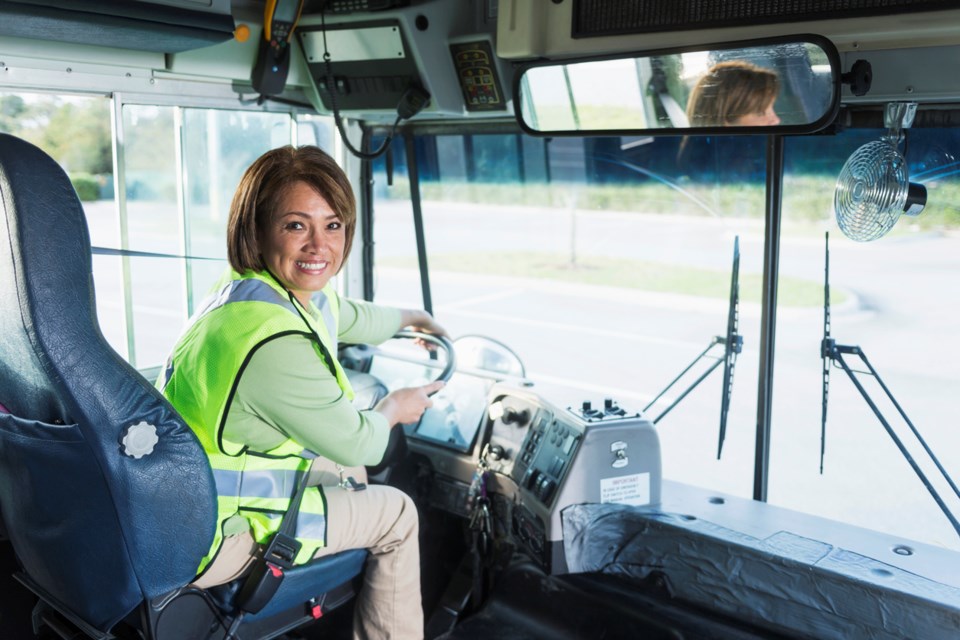The back-to-school season automatically comes with a blend of first-day jitters and excitement. This year’s COVID issue, however, threw out any past rule books and it is still in an evolutionary phase of learning, according to the Sudbury Student Services Consortium
For the Sudbury Student Services Consortium, which typically transports over 20,000 students on 400 buses, it was a whole new textbook in transportation for an agency who has a solid reputation for optimizing efficiency. The agency serves students in the Sudbury, Espanola and Manitoulin areas.
“We have close to 1,350 bus runs in our system and this represents a lot of work because it isn’t just about transportation,” says Renee Boucher, Executive Director, Sudbury Student Services Consortium. “It isn’t just about transporting students, it is also about ensuring the safety of students and making sure that traffic is stopping for the flashing lights before students cross in front of the bus plus we need to ensure discipline reports are being filed and all of this is done while on a schedule.”
The Sudbury Student Services Consortium transports students within the Rainbow District School Board, Le Conseil Scolaire Catholique du Nouvel-Ontario, the Sudbury Catholic District School Board, Le Conseil Scolaire public du Grand Nord de l’Ontario, and Huron-Superior Catholic District School Board.
“It is a very different world and we have nothing to compare it to so we’re trying our best to accommodate and ensure that kids are safely getting to school,” says Boucher.
Just before the start of the current school year, the agency received a new software application that was intended to ease some of the transition with seat assignments. They also received the list of students who would be attending school and those who would be learning through home-based settings. This software was necessary to identify the best way to efficiently run the bus routes as well as factor in social distancing in very tight quarters.
“The program was created to ensure students were with their cohorts and siblings sat together,” she says. “Our challenge has been that some parents opted in saying that their children would be taking the bus but our attendance records (on the bus) have identified them as either opting to drive them or go with the virtual learning option.”
She explains that this complicates the planning of the bus runs because those children were factored into the pick-up route. It only takes two days to add a student to the bus route, however, someone holding a space but not actually using it may mean that another student can’t be currently accommodated with the most efficient bus route. The attendance records, maintained by the drivers, also help with contact tracing, which helps public health, should an outbreak occur so it is imperative to know if a child is or isn’t using that bus service.
Boucher admits that the transportation software isn’t flawless and that a new version, set to be uploaded in October, will address some of the issues.
“There are tons of parents who understand what it is we’re trying to do and have been extremely patient and we so greatly appreciate it,” says Renee. “There are also some parents who we ask to take into consideration that we are trying to deal with all kinds of new learning and adjustments, often on a daily basis, while in the middle of a pandemic. We, too, are also experiencing that upset in life that has impacted everyone.”
Another huge challenge in meeting the needs of student transportation involves the actual bus drivers.
“Most of our bus drivers are in the vulnerable age category of over 65, and if a driver exhibits symptoms, they have to step down,” she explained. “And it can take up to eight days to get an appointment to get tested.”
Boucher says a lot of drivers decided it was not worth risking their health. During the first week of school, driver shortages saw 25 routes cancelled. It then went down to 19 routes, then 14 routes and by mid-October, it drops to 10 routes as four newly licensed drivers join the fleet.
“Many of our bus drivers are already retired and they look upon this job as a way of continuing to do something in their community so it is a loss for them in other ways, too,” says Boucher.
The call for new bus drivers was, and remains a priority. Typically, it takes three weeks to train a driver followed by the Ministry of Transportation testing. Also, all prospective bus drivers must pass their required medical, criminal and vulnerable persons record checks which, in total, can bring the whole application process up to about six weeks before a driver can get behind the wheel.
“The actual training is offered by school bus operators and right now we’re seeing trainers having to step in to fill the driver roles because we need drivers but that now means delays in training the new drivers,” says Boucher. “But we are starting to make progress.”
Boucher says the whole aspect of community-mindedness towards supporting one another’s efforts in a pandemic that is far from over, is paramount.
“This year is about the community coming together to support one another and we need people to be respectful of our big yellow buses and all of the ways that we’re trying to be efficient while keeping safety, both traditional and COVID-related, as our constant focus.”
Information on bus routes, delays, policies and procedures of the Sudbury Student Services Consortium can be found at www.businfo.ca/en/.
